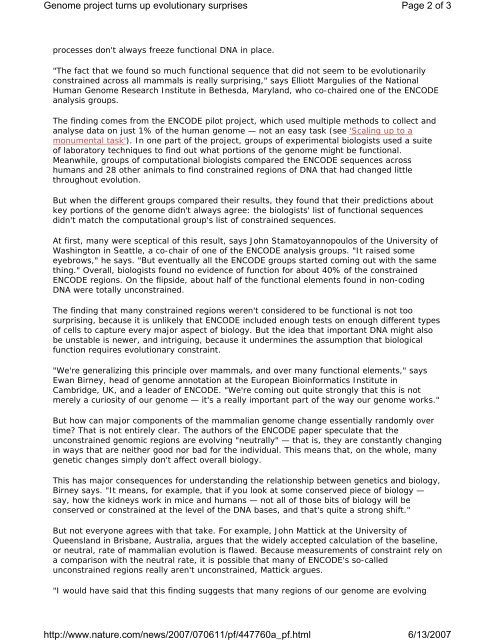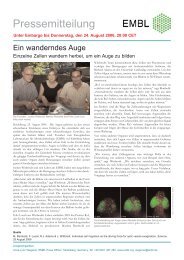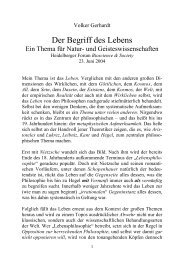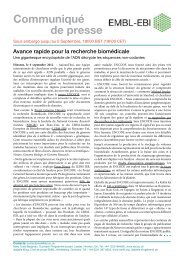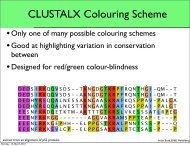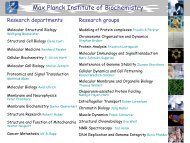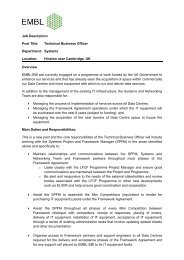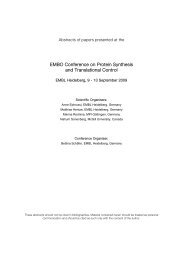Media Clips - EMBL
Media Clips - EMBL
Media Clips - EMBL
Create successful ePaper yourself
Turn your PDF publications into a flip-book with our unique Google optimized e-Paper software.
Genome project turns up evolutionary surprises<br />
processes don't always freeze functional DNA in place.<br />
Page 2 of 3<br />
"The fact that we found so much functional sequence that did not seem to be evolutionarily<br />
constrained across all mammals is really surprising," says Elliott Margulies of the National<br />
Human Genome Research Institute in Bethesda, Maryland, who co-chaired one of the ENCODE<br />
analysis groups.<br />
The finding comes from the ENCODE pilot project, which used multiple methods to collect and<br />
analyse data on just 1% of the human genome — not an easy task (see 'Scaling up to a<br />
monumental task'). In one part of the project, groups of experimental biologists used a suite<br />
of laboratory techniques to find out what portions of the genome might be functional.<br />
Meanwhile, groups of computational biologists compared the ENCODE sequences across<br />
humans and 28 other animals to find constrained regions of DNA that had changed little<br />
throughout evolution.<br />
But when the different groups compared their results, they found that their predictions about<br />
key portions of the genome didn't always agree: the biologists' list of functional sequences<br />
didn't match the computational group's list of constrained sequences.<br />
At first, many were sceptical of this result, says John Stamatoyannopoulos of the University of<br />
Washington in Seattle, a co-chair of one of the ENCODE analysis groups. "It raised some<br />
eyebrows," he says. "But eventually all the ENCODE groups started coming out with the same<br />
thing." Overall, biologists found no evidence of function for about 40% of the constrained<br />
ENCODE regions. On the flipside, about half of the functional elements found in non-coding<br />
DNA were totally unconstrained.<br />
The finding that many constrained regions weren't considered to be functional is not too<br />
surprising, because it is unlikely that ENCODE included enough tests on enough different types<br />
of cells to capture every major aspect of biology. But the idea that important DNA might also<br />
be unstable is newer, and intriguing, because it undermines the assumption that biological<br />
function requires evolutionary constraint.<br />
"We're generalizing this principle over mammals, and over many functional elements," says<br />
Ewan Birney, head of genome annotation at the European Bioinformatics Institute in<br />
Cambridge, UK, and a leader of ENCODE. "We're coming out quite strongly that this is not<br />
merely a curiosity of our genome — it's a really important part of the way our genome works."<br />
But how can major components of the mammalian genome change essentially randomly over<br />
time? That is not entirely clear. The authors of the ENCODE paper speculate that the<br />
unconstrained genomic regions are evolving "neutrally" — that is, they are constantly changing<br />
in ways that are neither good nor bad for the individual. This means that, on the whole, many<br />
genetic changes simply don't affect overall biology.<br />
This has major consequences for understanding the relationship between genetics and biology,<br />
Birney says. "It means, for example, that if you look at some conserved piece of biology —<br />
say, how the kidneys work in mice and humans — not all of those bits of biology will be<br />
conserved or constrained at the level of the DNA bases, and that's quite a strong shift."<br />
But not everyone agrees with that take. For example, John Mattick at the University of<br />
Queensland in Brisbane, Australia, argues that the widely accepted calculation of the baseline,<br />
or neutral, rate of mammalian evolution is flawed. Because measurements of constraint rely on<br />
a comparison with the neutral rate, it is possible that many of ENCODE's so-called<br />
unconstrained regions really aren't unconstrained, Mattick argues.<br />
"I would have said that this finding suggests that many regions of our genome are evolving<br />
http://www.nature.com/news/2007/070611/pf/447760a_pf.html<br />
6/13/2007


